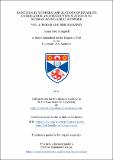Paintings by numbers : applications of bivariate correlation and descriptive statistics to Russian avant-garde artwork
View/
Date
22/06/2017Author
Supervisor
Keywords
Metadata
Show full item recordAltmetrics Handle Statistics
Altmetrics DOI Statistics
Abstract
In this thesis artwork is defined, through analogy with quantum mechanics, as the conjoining of the nonsimultaneously measurable momentum (waves) of artwork-text (words within the primary sources and exhibition catalogues) with the position (particles) of artwork-objects (artist- productivity/exhibition-quantities). Such a proposition allows for the changes within the artwork of the Russian avant-garde to be charted, as such artwork-objects are juxtaposed with different artwork-texts from 1902 to 2009.
The artwork of an initial period from 1902 to 1934 is examined using primary-source artwork-text produced by Russian artists and critics in relation to the contemporaneous production-levels of various types of Russian-avant-garde artwork-objects. The primary sources in this dataset are those reproduced in the artwork-text produced by the 62 exhibitions described below, and those published in John E. Bowlt’s 1991 edition of Russian Art of the Avant-Garde: Theory and Criticism. The production of artwork in the latter period from 1935 to 2009 is examined through consecutive exhibitions, and the relationship between the artwork-text produced by these exhibitions and the artwork-objects exhibited at them. The exhibitions examined within this thesis are 62 containing Russian avant-garde artwork, held in Britain from 1935 to 2009.
Content analysis, using an indices-and-symptom analytical construct, functions to convert the textual, unstructured data of the artwork-text words to numerical, structured data of recording-unit weighted percentages. Whilst artist-productivity and exhibition-quantities of types of artwork-object convert the individual artwork-objects to structured data. Bivariate correlation, descriptive statistics, graphs and charts are used to define and compare relationships between: The recording units of the artwork-texts; the artist-productivity/ exhibition-quantities of types of artwork-objects; the structured artwork-text data and structured artwork-object data.
These various correlations between structured artwork-text data and structured artwork-object data are calculated in relationship to time (Years) to chart the changes within these relationships. The changes within these relationships are synonymous with changes within Russian avant-garde artwork as presented from 1902 to 1934 and within the 62 British exhibitions from 1935 to 2009. Bivariate correlations between structured artwork-texts data and structured artwork-objects data express numerically (quantitatively) the ineffable relationships formed over time by large sets of unstructured data in the continued (re)creation of artwork.
Type
Thesis, PhD Doctor of Philosophy
Rights
Attribution-NonCommercial-NoDerivatives 4.0 International
http://creativecommons.org/licenses/by-nc-nd/4.0/
Embargo Reason: Electronic copy of Graph 3.1.3.1 is restricted permanently
Collections
Except where otherwise noted within the work, this item's licence for re-use is described as Attribution-NonCommercial-NoDerivatives 4.0 International
Items in the St Andrews Research Repository are protected by copyright, with all rights reserved, unless otherwise indicated.


